When it comes to design in communications, there are generally two types of artwork: design driven by narrative or design driven by information and data. The former relies more on conveying meaning and subtle messages through nuanced design, whereas the other relies on turning potentially incredibly complex or technical data into something that is much easier to digest for the average person.
Related: 7 guidelines for managing client expectations
Given the nature of corporate design, it will normally be brands who are requesting this type of work. These can be big money clients, so it’s important to make sure that you’re giving your client what they need. With that said, here are some tips to make sure your corporate designs hit the mark.
Know the brand inside-out
Unless you’ve had the fortune of pulling together the branding guidelines yourself, chances are you’re going to be unfamiliar with the brand. You need to spend time getting to know its identity. If there isn’t a set of guidelines anywhere, there are generally two things you can do:
Speak with your contact at the company.
Whoever has commissioned you to do this design work will most likely be willing to talk with you for 20 minutes or so and answer any questions you might have.
Put yourself in the position of their audience.
Have a look at their social media channels, watch the videos they’ve released, read through their website, and make sure you jot down notes about what messages you are getting from these. Mention these to your contact at the brand and check to see if that’s the message they want to portray.
“Peruse their back catalogue of materials in your spare time. It will help you know where the company has been, which will help inform you where it should be going. There have been countless times when I thought I came up with a great idea only to find out that we already tried it ten years ago.”
Aperitif5Destruction, via Reddit
Have the confidence to say no
Remember that, in any client relationship, you are the designer. They aren’t just paying for your time to deliver a service; they are paying for your skills, your experience and your influence. If the client gets back with some suggested changes that don’t fit in with the brand, you need the confidence to explain why their idea might not fit their guidelines.
“[As designers] our job is to educate clients on why we make the decisions we do, based on precedent, legibility and/or function. If a client is telling us how to design, they’re probably not a client worth having.”
Jesse Reed, via FastCodeDesign
Know the difference between internal & external communication
I spoke with my friend Neil who works in-house for a global technology recruiter and asked for his advice. He made a great point about the importance of separating design for internal use and for external use, and considering separating flagship publications from the brand.
“What we’re saying is ‘this is a great piece of marketing that you’re going to want to read,’ a lot of great stats, a lot of great information, and it’s presented in a way where it looks different, but it’s still within the branding guidelines, and it’s still within the context of FRG Technology Consulting (formerly known as Pearson Frank). And that’s the same with all of the salary surveys; they look different visually, but the context of which they’re promoted, of which they’re delivered, is within the brand.”
Neil Robinson
Key takeaways
Great corporate design doesn’t have to be difficult. Know the brand better than anyone else, put yourself in the position of the audience, have the confidence to defend your design rationale, and know the difference between designing for internal communications versus external. Follow that advice, and you will be delighting clients with your designs.
Ready to design corporate documents? Create beautifully branded reports, business cards & more in a matter of minutes.
Turning your business into a franchise is an exciting process for you and future franchisees. An essential part of creating a franchise is drafting your franchise disclosure documents, often referred to as FDD. These documents help you determine whether your business should be turned into a franchise and how to plan the transformation.
Related: 7 tips to coordinate local & national franchise marketing
The FTC created this document in response to a number of complaints. In years past, salespeople would convince franchisees to invest in a franchise without all the necessary information. This caused many people to lose their investments.
Now, the FTC states that franchisors must give potential franchisees the FDD at least 14 days before any contracts are signed or any money is exchanged, so the franchisee can make an informed decision about their investment.
Franchise disclosure documents have a very specific format, divided into 23 sections that cover all the information a potential franchisee might need to make an informed decision and sign a contract.
FDD sections explained
Below are the 23 sections that are required for a Franchise Disclosure Document and a brief explanation of what each of those sections cover.
1. The franchisor and any parents, predecessors, and affiliates
This section covers the history of your franchise business, any parent company or companies that have come before the current franchise. This is also where you give an overview of your business model, the competition, and an offer to become a franchisee.
2. Business experience
Provide the backgrounds of key directors, officers, managers and employees who have played a large role in the sale and management of the franchise. This section is all about giving an introduction to the key players in the franchise and reviewing their past business experiences.
3. Litigation
In this section, discuss any past or current litigation your franchise has been involved in. This level of transparency is critical for earning your franchisees’ trust and making sure they’re well-informed.
4. Bankruptcy
Here, you discuss any bankruptcy that has occurred within the business. This includes not just bankruptcy that’s occurred within the company, but also to any of the key people involved in the franchise.
5. Initial fees
This is where you outline any of the deposits and fees the franchisee will have to pay in order to gain ownership and start up their own franchise within your business.
6. Other fees
Here, you outline the fees that will continue for as long as they own and operate the franchise. What ongoing royalties or yearly fees will you charge your franchisees for advertising, renewal of their ownership, or transfers? Make sure you provide a complete and accurate list.
7. Estimated initial investment
This section covers any costs the franchisee will incur to get the franchise up and running. This includes advertising, the cost of operations, and any other costs that may arise before the franchisee starts making revenue.
8. Restrictions on sources of products and services
This is where you include any restrictions you have regarding the sources and types of products and services offered through your franchise.
9. Franchisee’s obligations
In this section, you provide a clear reference to all the obligations the franchisee is agreeing to when they sign this contract.
10. Financing
Here, you describe any financing options or programs available through the franchise.
11. Franchisor’s assistance, advertising, computer systems, and training
This section details the obligations you have as a franchisor when you sign a contract with a franchisee. This section tends to be the longest, as it includes any assistance you offer before their business is open, as well as any ongoing assistance. In this section, you also outline any advertising assistance that will be provided for the franchisee.
Include information regarding any franchisee training programs offered through the franchise, as well as the support offered through the computer systems used throughout the business.
12. Territory
This section covers any territory offered to the franchisee and whether the territory will be changed because of this agreement. This section is going to vary greatly between different franchises, as each has its own philosophies regarding territory.
13. Trademarks
Here, you include information regarding your franchise’s trademarks.
14. Patents, copyrights, and proprietary information
Similar to the previous section, this section outlines information regarding the patents, copyrights and other information about how the franchisee can use these copyrighted materials.
15. Obligation to participate in the actual operation of the franchise business
In this section, you explain the personal obligations the franchisee will have in the actual operation of the business. These can vary greatly, so be specific.
16. Restrictions on what the franchisee may sell
This is where you outline any products or services the franchisee cannot offer from their franchise locations. These restrictions will determine what franchisees can or cannot offer at their location.
17. Renewal, termination, transfer, and dispute resolution
This section covers the costs or renewal, termination or transfer for franchisees. This is also where you cover how you and franchisees will handle disputes. These policies are critical to running a smooth franchise operation with as few disruptions as possible.
18. Public figures
If you use public figures (e.g. celebrities or public persons) for advertising or promotions, then state the amount they are paid here.
19. Financial performance representations
This section is where you provide information regarding the financial performance of other franchise units. According to Entrepreneur:
“The typical Item 19 disclosure consists of three types of information: 1) numerical presentations of revenue and/or expense data, 2) notes and explanations outlining the assumptions used in preparing these numerical presentations, and 3) disclaimers that carefully explain the limitations of the usefulness of the data presented.”
20. Outlets and franchisee information
This section lists information about all the other units within the franchise. This includes updated contact information for each unit, such as addresses and phone numbers.
21. Financial statements
This is where you include audited financial statements from the last three years.
22. Contracts
This is where you should put all the contracts the franchisee will be required to sign. Organizing your contracts this way makes it easier to find and reference them later.
23. Receipts
Franchisees are required to sign a receipt stating that they received the FDD. This protects your business and proves to the FTC that you did your due diligence. It will be placed at the end of the FDD.
Key takeaway
Your franchise disclosure documents are vital to maintaining your business’ health and your franchisees’ success. It’s important that you keep this document in order, up-to-date, and written in clear, concise language.
Your brand matters. If you’re ready to build your franchise brand into a consistent, compelling force that drives your business, this guide will show you how to get started.
Competition for customers is fiercer than ever, but a well-planned franchise marketing strategy can make you stand out from the crowd.
However, strategy is quite a complex subject. Can it be condensed into a simple article?
If you ask us, we say yes. We’ve distilled the most important steps a marketing strategy should contain. You’ll see in the examples below that even major brands follow the principles explained in this article.
Related: 4 best franchise softwares to boost your brand
Whether you’re a franchisor, a franchisee or a marketer, this is a great practical resource for you because every principle here is backed with concrete examples to inspire you.
Ready? Let’s dive right in.
Segment your audience if you want to maximize your results
You already know that you can have the best product on the planet, the most persuasive sales message, or the most creative ad ever—but if you deliver it to the wrong person, it will never work, right?
This applies whether you’re a franchisor looking for franchise buyers or a franchisee who wants to attract more people to your business.
So, if you want to make the most of your marketing efforts, your marketing plans have to start with your core audience in mind.
Below, you can find a few essential questions to ask yourself (or even better, your existing customers) to find out who’s most likely to buy from you.
Questions to ask yourself & your team:
- What are your product/service’s best features, and how does each translate into a benefit for the consumer?
- What’s special about your product/service in comparison to your competition? Are you unique, cheaper, quicker, better value, safer? The most trusted, the first, the oldest, the most tested?
- What could be your customer’s main objections?
- Which topics are your customers interested in? Who influences your ideal client (books, publications, media, influencers, etc.)?
- Where can you catch your ideal customer’s attention? Phone, email, social media, TV?
- What is your ideal buyer’s income?
Questions to ask your existing customers:
- Why did you choose us and not a competitor? Is there anything that pushed you in favor of us?
- How did you find our website or location?
- How would you feel if you could no longer use us? What would you miss?
- What’s one thing you don’t like about a competitor, or that we could improve to better meet your needs?
- What would you likely use as an alternative if we were no longer available?
- Have you recommended us to anyone? Why or why not?
Prioritize channels
One of the biggest mistakes entrepreneurs make is trying to be on every platform out there.
Trying to tackle every channel available can be a great strategy if:
- You have the resources to do this (time + money + knowledge).
- Your audience is on every platform.
The first point is pretty clear. Few companies have the resources to go that broad with their marketing efforts. Second, often times, our audience isn’t everywhere.
For example, if your target audience is between 18 to 25 years old, you might be better off going for Instagram than Facebook.
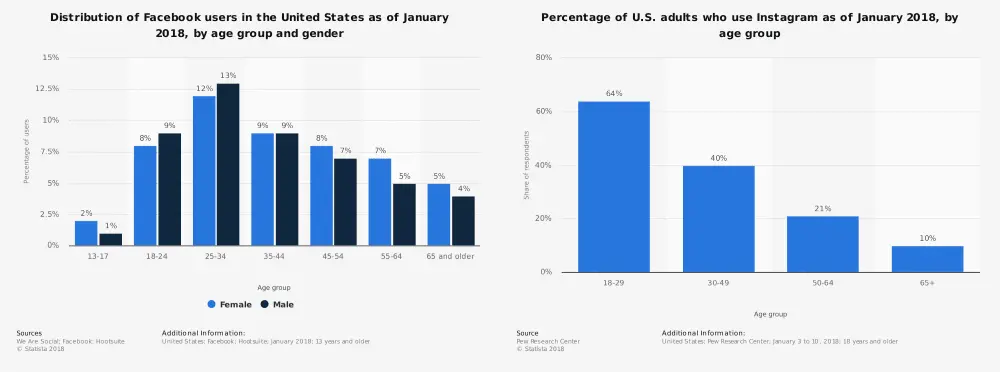
Source: Statista
Or, if you want to use Twitter as one of your main marketing channels in Europe, you might reconsider because Twitter hasn’t penetrated Europe as much.
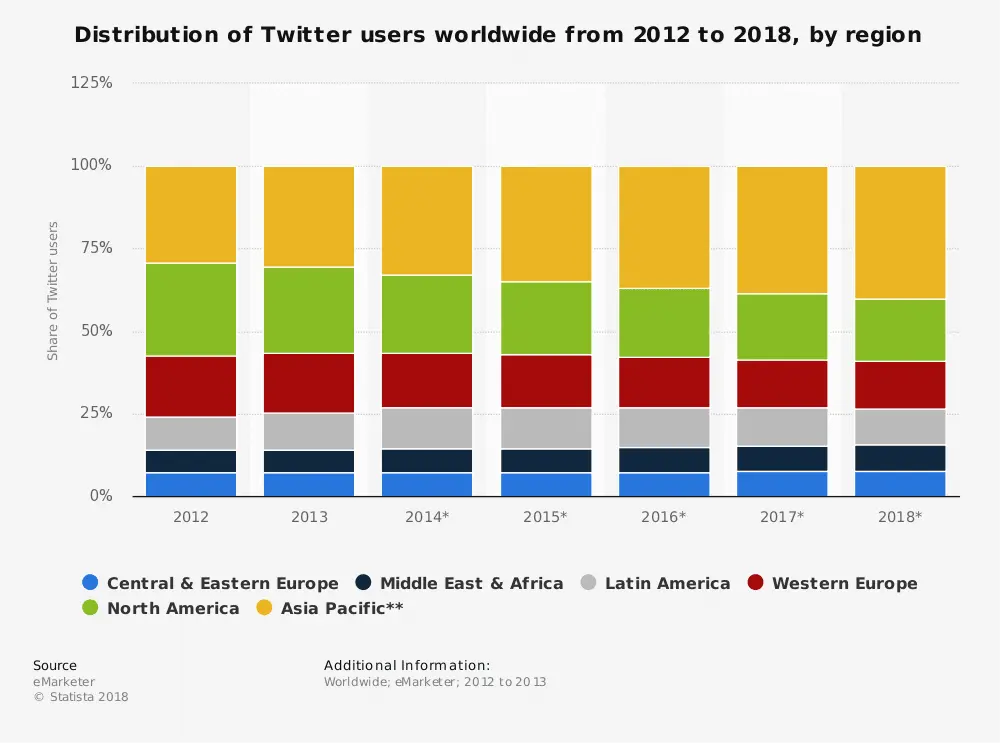
There are a lot of effective channels available. How do you prioritize them?
Here’s a simple, tested system borrowed from growth hacking marketing you can use. This is the same marketing concept used by startups like Facebook, Twitter, LinkedIn & Airbnb:
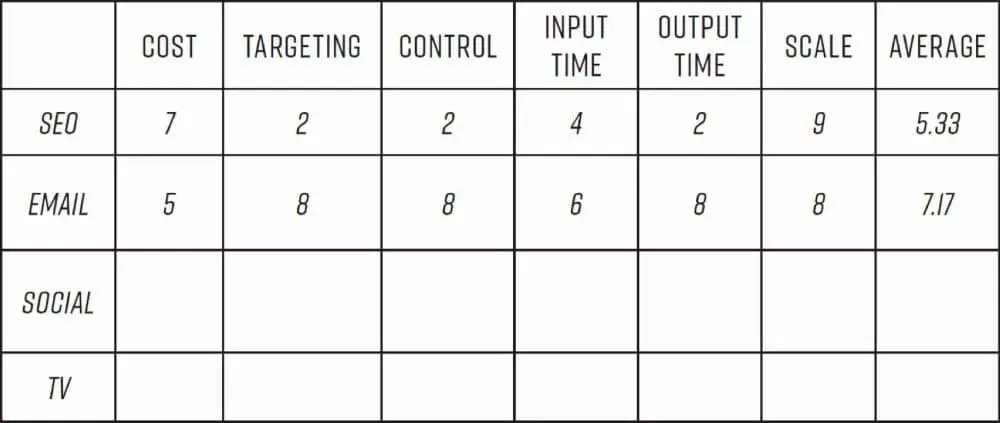
Source: GrowthHackers
Cost — how much you expect to spend on that particular channel (check cost statistics beforehand).
Targeting — how easy it is to reach your intended audience and how specific you can be. Does your chosen platform/channel have local advertising capabilities, for example?
Control — how much control you have once you go live. Can you stop it easily or adjust if it’s not going well? For example, it’s much harder to change a billboard than a Facebook ad.
Input time — how much time it will take to launch the experiment. Filming a television ad, for example, has a much longer input time than setting up a promoted tweet.
Output time — how long it will take to get results once it’s live. For example, search engine optimization (SEO) could be a great channel for your franchise marketing, but it has a much longer output time than pay-per-click does.
Scale — how large an audience you can reach with the experiment. Television offers much larger scale than advertising on a niche blog does.
Make sure you maintain consistent branding
Different channels require different creative.
Twitter is more text-based because people use it for news and articles.
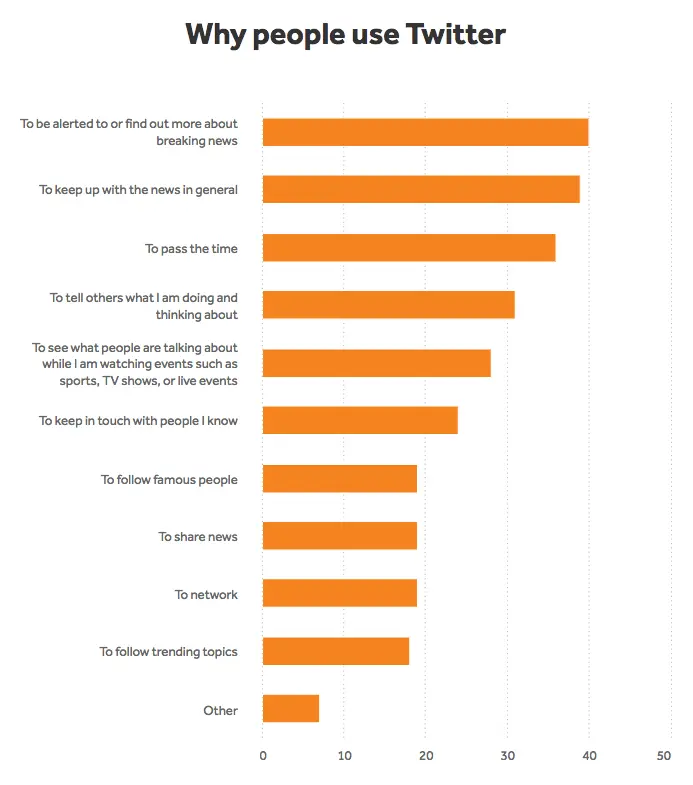
Source: Buffer
Instagram is a more visual platform and requires high-resolution photos.
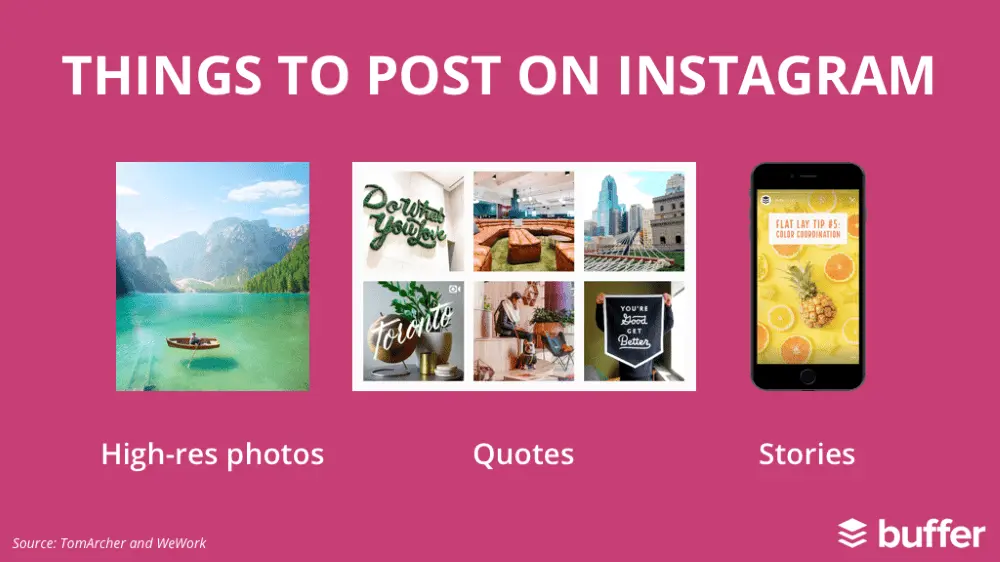
Source: Buffer
On Facebook, a recent BuzzSumo analysis found that videos have higher average engagement than images and links.

Source: Buffer
Therefore, no matter if you are a franchisor or a franchisee, you have to make sure you:
- Maintain consistent branding across all your franchises (as a franchisor).
- Maintain consistent branding across all your channels (as a franchisee).
What does this congruent brand identity actually mean? Below, you’ll find some real examples.
Communicate your value proposition in the same way across all channels—offline, online, TV, radio, direct mail or anything else. [![]() ]
]
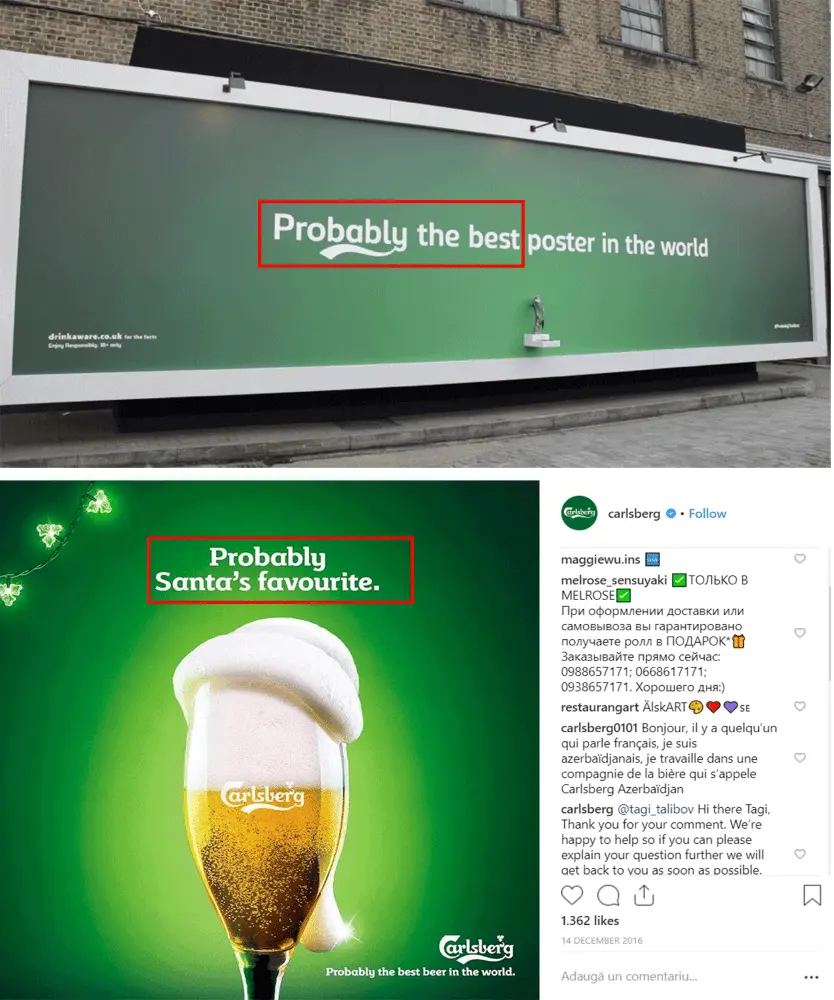
Your design (colors, logos, fonts, tone) has to be the same whether someone sees an ad on Facebook or landed on your website from a Google ad.
One of the best examples here is Coca-Cola.
As you can see, the color red is always present in one way or another. They also use the same fonts and design elements.

Another important element to a congruent brand identity is tone of voice.
If we continue our Coca-Cola example, we can see that almost all their posts express happiness, joy, fun, or the feeling of enjoying a great moment with friends.
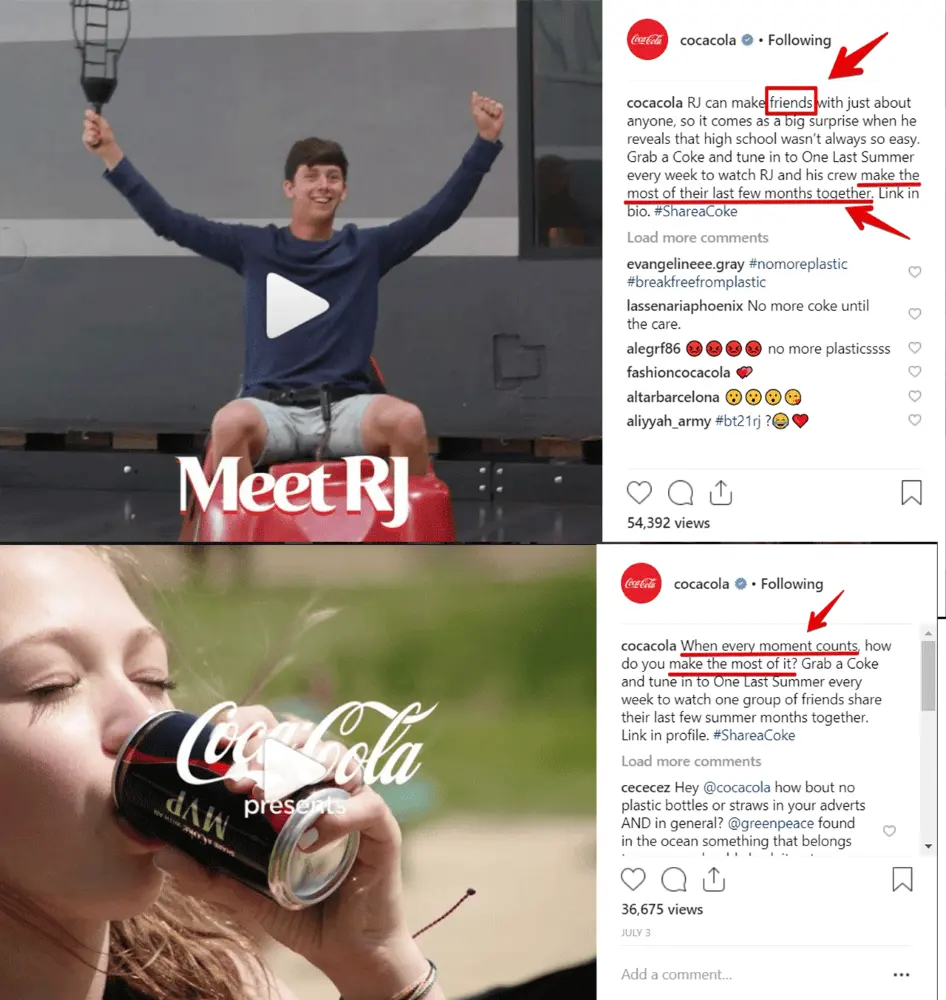
If we take another example, Charmin, you can see that whether they communicate offline or online, they maintain a playful tone.

How can you make sure your franchise brand stays consistent?
First, you’ll have to create a brand manual which includes details about your tone of voice, preferred professional terms, and general code of conduct. Every business should have one, no matter their stage in the journey to perfect branding.
(We’ve handpicked some of the best brand guideline examples for you.)
Then, in order to minimize errors, you can create “best practice” templates that are in line with your brand’s ethos and aesthetic.
This ensures no one in your company has to take matters into their own hands, because they can draw on templates that reflect your brand every time they create a new document.
If you’re using Marq, you can create & customize templates to easily create stunning content without having to start from scratch every time. And because of its innovative Brand Assets feature, you can make sure everyone is using the latest version of your branding elements. Fonts, colors and logos are all pre-loaded and ready to go.
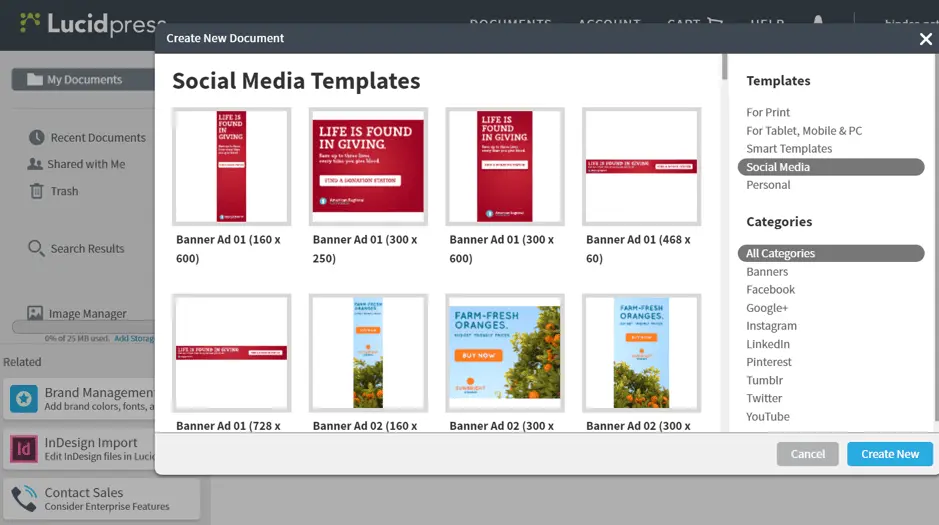
How can franchises maintain brand compliance across locations? Learn more in our free ebook, The complete guide to multi-location branding.

Before starting your efforts, make sure you can measure them
There’s an old adage that says half of the money invested in marketing is wasted. The problem is you don’t know which half.
Well, thanks to digital analytics, you can track your results so in-depth that you’d be amazed at how much leverage you have… if you measure the right things.
Here are just a couple of examples. Let’s say your marketing team developed two or three video messages for a certain audience, but you don’t know which one to choose.
It’s super easy. On Facebook, for example, you can check how much of your video was actually watched by a particular group.

If you compare it to television advertising, for example, you don’t get this level of accurate data. You can’t know whether a person left the room when the commercial started.
But, Facebook isn’t the only tool that allows you to track the results of your franchise advertising efforts.
If you run email marketing campaigns, you can see how many people opened your email and clicked on the offer inside.
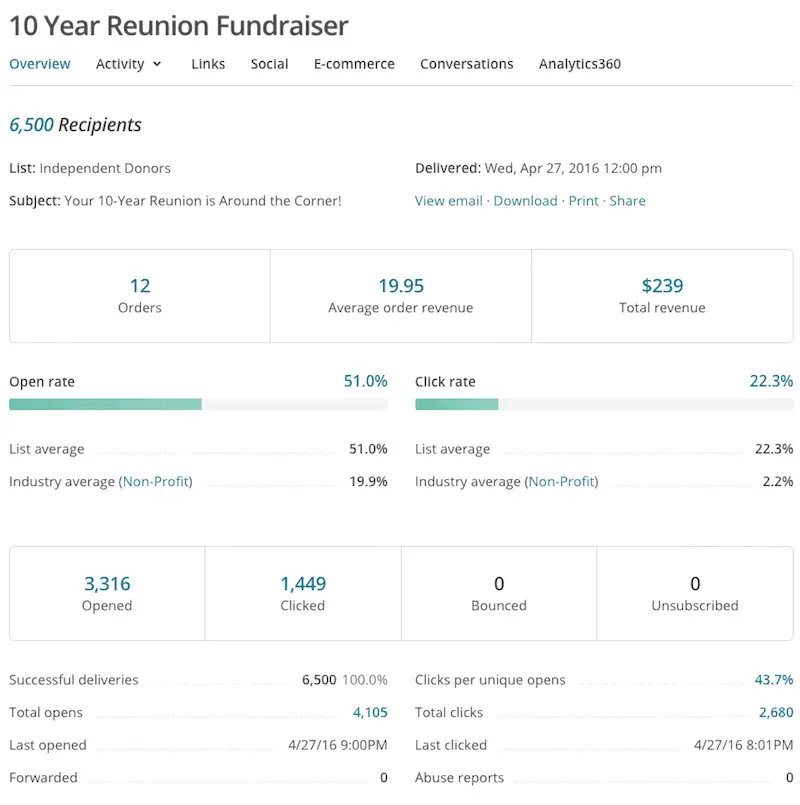
Source: MailChimp
If you run any other digital marketing campaigns, you can check Google Analytics to see how much time people spend on your website, which campaign brought in the best results, where the most traffic comes from, and much more.
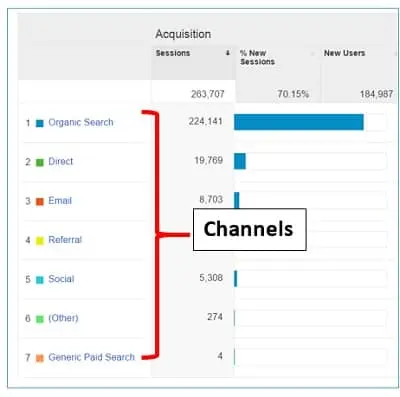
Source: Optimize Smart
Or, maybe you just bought a pizza franchise and you’re using local Google Ads. You can track how many times people called versus how much money you’ve invested and see if there’s a positive return on investment.
Ultimately, analytics don’t have to be limited to the online world. If you’re using offline marketing tactics like flyers or coupons, you can use codes to measure whether your campaign was a success.

Always keep an eye on trends
Marketing is first and foremost a battle for attention. If you don’t have people’s attention, you can’t communicate with them. If you can’t communicate, you can’t sell.
In the 50s, attention was on the newspapers, then on TV and radio.
Today, our attention is on social media. Messaging apps like Facebook Messenger are becoming more powerful.
Influencer marketing is growing, because they have people’s attention and they’ve already earned their trust.
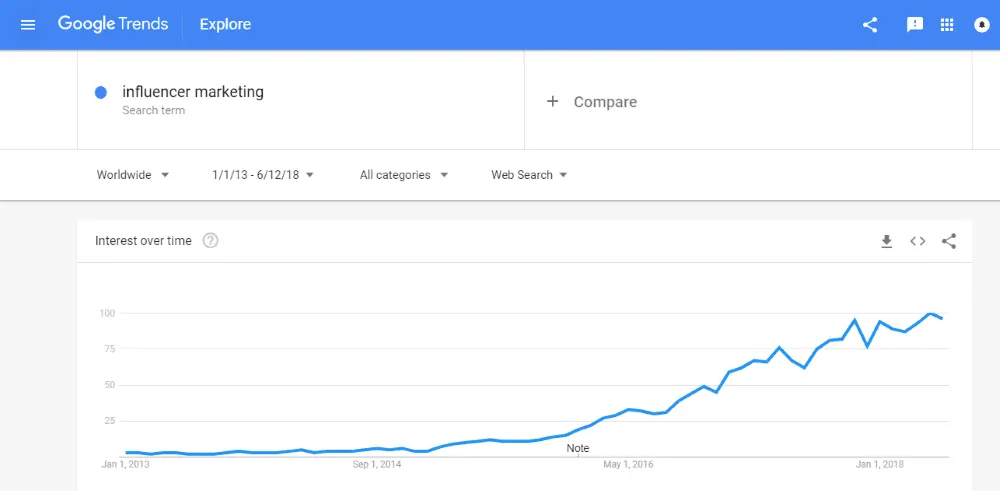
Source: Google Trends
What’s next? Voice search & marketing will have a huge impact on consumer behavior. More than 35 million Americans used a voice-activated assistant at least once a month in 2017, according to eMarketer.
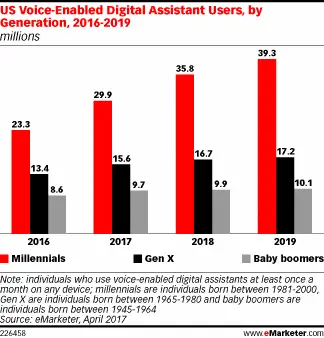
Coordinate local & national franchise marketing
There are many methods to handle franchise marketing. Sometimes, the franchisor and a corporate marketing team are wholly in charge. Other times, the franchisee takes on all marketing responsibilities. Most often, it’s a mix of the two.
It’s easy to see how this arrangement could cause confusion for your customers. But by coordinating your marketing efforts, your brand message will be strong and clear across all franchise locations.
Large-scale, national marketing campaigns
Here are some tips for coordinating large-scale marketing campaigns between the franchisor and franchisee.
Focus on the brand
In a franchise, the brand is often the selling point for customers. They know they can trust a certain brand and will support that franchise, no matter where they are. This is why it’s beneficial to focus on the overall brand image in your marketing efforts.
Provide a brand style guide
Franchisors can create a brand style guide for franchisees, to help them create on-brand materials and limit branding mistakes. It you aren’t sure how to create a brand style guide, take a look at this blog post for some killer examples.
Here at Marq, we’re pretty obsessed with staying on-brand and empowering everyone (even franchise owners who have no design experience) to create visual content. If you’re curious how Marq could streamline your franchise marketing, then check this out.
Communicate clearly & frequently
To maintain your brand image across multiple locations, communication is key. Set the precedent that there will be consistent communication regarding marketing efforts between the franchisor and franchise owners.
One area that’s often under-communicated is digital marketing strategy. The franchisor should coordinate website and social media creation with franchisees, so there aren’t multiple accounts that could confuse or misdirect customers.
Looking at these marketing strategies, the biggest factor is the brand. Build a strong brand identity that will give your franchises a good reputation, then give franchise owners the freedom to create their own marketing collateral using approved brand assets.
Small-scale, local marketing campaigns
Small-scale marketing strategies should focus on specific efforts in the local community. Franchises often have the good reputation of the larger brand, but localized marketing is what will win the community over and create a loyal fan-base.
By empowering franchisees to control their own marketing on a local level (and by giving them the tools to stay on-brand), individual franchise revenue will soar.
Here are more tips for localized, franchise-level marketing.
Find local sponsorships
Talk to local charities, sports teams or schools in the area to find opportunities to donate to a good cause and get some advertising. This is a great way to show community members that you’re invested in the area.
For example, when I was in high school, there was a Taco Time that always sponsored the school’s football and basketball teams. Their sponsorship included banners hanging up at the football field and inside the gym. They sold food at the concessions stand and had their logo printed on the game rosters. As you can imagine, my friends and I ate a lot of tacos.
This was a worthy investment for this franchisee, as it showed their support for the community and offered unique advertising opportunities. The owner of the Taco Time had a great relationship with the community and people loved going to his location.
Personalize your messages
When you’re advertising to a specific community, it’s important to personalize your messaging for your audience. Every community is different, and by catering to yours, customers will feel special and more inclined to support you.
A great example of marketing personalization is CrossFit gyms. Each gym (or “box,” in CrossFit lingo) has its own website and social media accounts that tailor their messages to the area where the gym is located. Whether it’s about the weather or events happening in the city, these gyms create a local identity for themselves that members can be part of.
Keep up-to-date
Encourage franchise owners to stay on top of trends and news as they create marketing for their franchises. Being in tune with the local news can help you spot opportunities and avoid embarrassing advertising mistakes.
Any time you post about current news or trends, make sure you do your research. An unfortunate example of this is DiGiorno. When the hashtags #whyistayed and #whyileft were trending on Twitter, DiGiorno tweeted “#whyistayed You had pizza.” The problem: these hashtags were dedicated to discussing and raising awareness of domestic abuse—an incredibly serious cause. Needless to say, many people were offended by the tweet and DiGiorno quickly apologized for its mistake.
Be where your audience is
This, of course, is one of the most important rules in marketing. No matter how clever and wonderful your marketing efforts are, if your audience doesn’t see them, then it’s a waste.
So, find out where your local audience is: Do they spend time on Facebook, Instagram or Twitter? Do they read the local newspaper? If so, that’s where you should be, too.
Be consistent with the brand
Much of the traction and business a franchise location enjoys comes from the brand name that it carries. To continue attracting and retaining that business, it’s important to stay true to the brand.
If the franchise brand is known for great customer service, then local managers have to make sure that customer service is a priority for them. Personalize each franchise to the local area, but stay true to the brand it represents. For example, maybe there’s a way to provide outstanding customer service that’s unique to your community.
A great example of this is Chick-fil-a. It’s a well-known fact that if you say “Thank you” to any Chick-fil-a employee, they will reply with “My pleasure.” Quality customer service is part of the Chick-fil-a brand, and customers can expect to receive the same level of customer service wherever they go. While each Chick-fil-a has its own concerted marketing efforts, they stay on-brand with their customer service.
Key takeaway
Marketing within a franchise can lead to miscommunication and overlap if the franchisor and franchisee do not coordinate their efforts. However, through communication and a good brand management system, your marketing efforts can complement one another and culminate in more success.
Before you start your franchise marketing strategy…
Everything starts with your ideal client in mind. From there, you decide which channels would bring you the best results, depending on your budget.
Next, you have to make sure your brand identity stays consistent across all channels—from your value proposition to your design elements.
Then, make sure you keep an eye on the latest trends in order to leverage first-mover advantages. This strategy will give your franchise business the best chance at standing out and finding success with your preferred customers.
Maintain brand consistency with Marq, the brand management platform for franchises. It’s perfect for franchise brands of any size.
If it seems like new Starbucks locations are popping up faster than weeds in your backyard, there’s a sound reason behind it. Successful franchises rapidly expand their reach because they begin with an effective business plan and focus on growth.
Related: Franchise development—what you need to know
Creating a business plan is the necessary first step for any business owners who want to bring a franchise into a new market. Well-crafted franchise business plans are the equivalent of an elevator pitch. Business owners can use them to convince others to invest the capital they need to hit the ground running. Lenders also require a business plan before they will sign off on any loans to a prospective franchise owner.
Creating your franchise business plan
A typical business plan includes four main sections. You can touch on these sections in an executive summary, then break down the details in each individual section. Each section functions like a signpost on the roadmap you’re drawing for your new business to reach its goals. Here’s an overview of those four sections and what they should include.
Business description
The purpose for this section is basically self-explanatory. It offers basic and essential information on the franchise itself. For example, it describes the products and services your business offers. You can also identify your customers and how your business will help them.
You should evaluate the market where you wish to set up shop and include information about it in this section. This includes an analysis of your direct competitors, identifiable challenges or risks that come with doing business in that market, and a breakdown of your target demographic. Discuss how you will approach and manage each of these factors within your business operations.
Management
Your business plan needs to detail your company’s management structure and any related core values or philosophies. Which positions will be responsible for managing day-to-day operations? Who will fill these positions? What qualifications and skills are required for each position? How will you hire and train the necessary personnel? What salaries and benefits will you offer to these employees?
Discuss the individuals who will be filling management and leadership roles on your team. Explain—in depth—what makes those particular individuals qualified to succeed in those roles. Franchising is only as successful as the management team doing the work behind the scenes, and the people reading your business plan will look over this section carefully.
Marketing
A new business can only succeed if it uses the right formula to reach potential customers and turn them into real customers. This is where your marketing plan comes into play. Your business plan should detail how you will reach customers and convince them to walk through your door.
Doing thorough market analysis is critical in this part of your overall planning. You need to identify your customers, assess their needs, and determine how your business will fulfill those needs. How will this data shape your pricing? What is your potential market share? Outline how you will market your business to reach that target demographic.
Financial projections
It takes a significant investment of capital to get any business off the ground, and franchises are no exception. Investors and lenders will be most concerned about turning a profit. They don’t want to sink funding into a business that will end up folding like a paper airplane at the first sign of trouble.
Your plan should outline a realistic budget that includes both startup costs and operating costs. These financial projections should cover your cash-on-hand, franchise purchasing fees, startup costs and operational costs. The budget should cover operational costs over a three- to six-month period.
Discuss how much capital you’ll need to cover these costs until your business turns a profit. You also need to demonstrate the accounting and inventory control systems your franchise will use. Include income statements, cash flow projections, and data sheets to project how your business will do once it opens its doors. Financial projections should be conservative and take into account as many variables as possible.
Getting to work
There are many great resources available to help you structure your business plan so that it conveys the message you intend with confidence. Franchise business plan templates can help you see what works best and how to put your vision into the right words. You can pick from assorted stock images, fonts, colors and other design elements to make it visually appealing and reflect your franchise’s brand voice.
If you’re not a professional designer, Lucidpress can help you start out on the right foot. We offer plenty of templates suited to meet your business document needs. Our intuitive online editor makes it easy to design traditional printed documents or embrace the virtual realm with interactive digital documents. Check out our template gallery for a dose of inspiration, then sign up for a free Lucidpress account to take one for a test drive.
Your brand matters. If you’re ready to build your franchise brand into a consistent, compelling force that drives your business, this guide will show you how to get started.
The more appealing a proposal is, the more likely you’ll be to win the job. Seems simple enough, doesn’t it?
But, creating proposals that are professional, detailed, attractive and on-brand isn’t easy. Especially when you’re trying to do it quickly.
Related: How to create engaging assets for your sales team
The good news is that proposal management software can help you speed up and improve the process.
In this post, we’re going to look at 5 tools that can help you, as well as explore the benefits and key features of proposal software.
The benefits of proposal management software
Central location
Store everything in one central, cloud-based location and access it from anywhere you get online. Assign access to multiple team members as necessary and collaborate in real time.
Act quickly
With templates and automation, creating proposals is much faster. Generate pitches, proposals and presentations quickly and simply, and make the most of opportunities as they happen.
Streamline the entire process
When you can create, collaborate on, approve and distribute your proposals in one neat system, it removes the need for complicated processes that use multiple pieces of software.
Notable features of proposal management software
Searching for proposal management software can be overwhelming. There are so many options on the market, each with varying features.
To help you make the right choice, consider the 4 elements below and decide which would be most beneficial for your situation.
1. Branded templates & pre-filled forms
Proposal creation takes time, but with ready-made templates and automation that allows you to pre-fill forms, the sales process will move much faster.
Even the most basic proposal automation software should carry this feature, but it’s the extras—like being able to brand and fully customize the templates—that will give you that professional edge.
2. Mobile-ready
If your sales team spends a lot of time in the field, proposal generator software that works on mobile devices could quickly put you ahead.
When a sales rep can input key information while on the road, at a meeting or on-site, a professional proposal can be turned around in days rather than weeks.
Also, being able to give on-the-spot estimates straight from a handheld device means the conversation can progress more quickly. If this is important to you, you might want to consider software that can integrate with or replace your CPQ (computer pricing quote software).
3. Customer relationship management
From the minute an RFP starts to form, a CRM process should be initiated for tracking purposes. The better your sales team is at nurturing leads and following up after proposals have been sent, the higher your chances of success.
Proposal automation software that comes with CRM features will empower your sales team to make the most of every opportunity.
4. Smart reporting
Where time and money are being put into drawing up proposals, the return on investment should be measured. The better you get at analyzing the data, the more refinements you’ll be able to make to your sales process.
Some proposal automation software will come with built-in reporting tools, though this could just as easily be managed with a spreadsheet. Software might offer an expanse of reports, but it needs to be easy to learn. If it’s overly complicated, it won’t be as effective as it could be.
5 proposal automation & management tools
To find the right proposal generation software for you, you’ll need to weigh up your requirements against the features on offer.
Consider the 4 elements we’ve listed above as well as any other functionality you’re looking for. Do any of the following proposal management tools seem to offer the ideal solution?
1. Bidsketch

Bidsketch allows you to make customized proposals using saved sections that can be combined to build a full document.
Features include:
- Templates & reusable content
- Optional fees (for upselling additional services)
- Client landing pages
- Automation & workflows
- Electronic signatures
- Analytics
2. Nusii

Proposal management software Nusii lets you personalize templates and track the proposal process.
Features include:
- Proposal notifications
- Unique branding, domain & email
- Reusable content
- Reporting
3. RFPIO

Compared with the proposal management tools we’ve looked at so far, RFPIO is more advanced. It’s likely to be a better fit for larger organizations with a lot of activity.
Features include:
- Import & export data
- Answer library
- Intake forms
- Project management
- Collaboration & commenting
- Recommendation engine
- Integrations
4. PandaDoc

PandaDoc handles proposals, quotes and contracts. It also integrates with popular CRMs like HubSpot and Salesforce.
Features include:
- Templates
- Content library
- Brand customization
- Electronic signatures
- Pricing tables
- Collaboration & commenting
5. Lucidpress

Lucidpress is a brand templating platform for businesses that want to align sales & marketing and manage brand consistency, while also empowering their people to customize materials quickly.
Its features include:
- Fully customizable proposal templates
- The ability to lock elements within a template (e.g. fonts, colors, logos)
- Smart fields for pre-filling data like names & contact details
- Automatic data population
- A central storage location
- Real-time collaboration
- Instant digital sharing
- In-app printing & mailing
Using Lucidpress to create on-brand proposals
Of course, we have a favorite. With Lucidpress, it’s easy to create quick proposals that are on-brand.
Put another way, Lucidpress is a design platform with brand management capabilities. It’s a tool for designing sales & marketing materials, with plenty of additional features that make brand consistency achievable.
The benefits of Lucidpress include:
- One central storage system that’s cloud-based, meaning it can be accessed from anywhere.
- An intuitive design tool where templates can be created from scratch or imported from InDesign.
- Templates where key elements (such as logos, brandmarks & crucial text) are locked in.
- Document automation, to save time on tedious tasks like importing data or filling out frequently used information.
- Customization options that allow team members to personalize templates as needed.
- Easy distribution via instant online sharing or an in-app printing & shipping service.
How to create proposals in Lucidpress
To give Lucidpress a try for creating and automating proposal generation, follow the short guide below.
1. Design the template
Build a template from scratch (or import from InDesign) using the intuitive drag-and-drop design tool. Customize it completely to mirror other assets and keep your proposals on brand.
(Not sure where to start? Check out our library of proposal templates for inspiration.)
2. Add smart fields
Reduce admin time with smart fields in Lucidpress. Use them to auto-populate your proposal template with things like names, email addresses and contact details.
When a sales representative begins to customize your template, it’ll auto-fill with their details.
3. Lock brand elements
Before you make your template available to others, though, you should lock in the crucial elements.
Fix logos, brand names, and essential elements in place to maintain control over the brand and the way the document is structured.
4. Empower your team to customize
Next, make the template available to colleagues. Give them access to the central document store in Lucidpress.
Teach them how to customize the template so they can generate professional, on-brand proposals in minutes.
5. Distribute to potential clients
Use Lucidpress to share proposals instantly online, or to order & deliver printed versions. It offers a number of digital and print-ready file formats, so you can share documents with anyone anywhere.
Key takeaways
The primary benefits of proposal automation software include:
- central storage
- a streamlined process
- the ability to work faster
There are hundreds of proposal automation tools on the market. Before you invest, you need to understand which features are most important to you.
Lucidpress can help you protect your brand and align sales & marketing content. With lockable proposal templates that are stored centrally and easily customized by sales reps, you can streamline and speed up your proposal process.
When you’re a sales manager, you need to keep your finger on the pulse with consistent updates on your team’s performance. It could feel like you’re selling well, but unless you use regularly updated key performance indicators, you won’t know for sure.
Related: What is sales enablement?
If you’re looking for a refresher – or even an introduction – for the kinds of KPIs you should be watching as a sales leader, we’ve got four critical KPIs for you to start with. But first, as always… the basics.
What are KPIs?
Key performance indicators, or KPIs, are vital statistics your team can use to help it sell better. Not only do they show you how many sales you’ve made over the last week, but you can also leverage them to chart your performance over time. A KPI can help you measure what you’re doing right (or wrong) and provide important evidence that your strategies are working.
KPIs also help you become a better sales manager. Instead of blindly tinkering with your sales processes, KPIs offer data-driven insights as to whether or not your adjustments really are beneficial to your team and your company’s business goals.
In other words, KPIs play an essential role in supervising & developing a high-functioning sales team.
If you’ve never come across KPIs before or haven’t used them diligently in the past, what we’re talking about could seem a little abstract. To help you better understand KPIs and what goes into creating them, we’ve identified four key measurements you should be tracking. Take them for a test drive, and you’ll soon see how helpful these metrics are for improving the effectiveness of your sales team.
How to create KPIs for sales
KPI #1 — Sales cycle length
The sales cycle length is the time between your first touchpoint with a customer and when you close the deal. It could be seconds, or it could be years — it all depends on the type of business you’re managing.
Let me reiterate that: Not all businesses operate with the same sales cycle length.
For example, a local convenience store has a sales cycle length of about two minutes. A customer walks through the door, picks up a pint of milk, goes to pay for it at the checkout, and the sale is complete.
The same is not true of an enterprise software solutions provider. It could be months (or even years) between a business customer becoming aware that the product exists and actually buying it.
As a sales manager, you’ll want to track your company’s sales cycle length. It helps you forecast how many sales you’ll make in the future. Keep in mind, if you have a long sales cycle, you can use sales cycle length to estimate the number of conversions you’ll receive over the next quarter based on your current list of prospects.
Unsure how to calculate your average sales cycle? No stress — we’ve got you covered.
- Gather up your numbers from the past sales cycle. For example, you can track how long it took to close deals last quarter in a spreadsheet: Deal #1 took 4 days, Deal #2 took 7 days, and so on.

- Add up how many days it took to close each deal to get the total number of days it took to close all deals. This is easier than it sounds – it’s just a sum. For example, Deal #1 + Deal #2 + [etc.] = 24 days.

- Divide the total number of days by the total number of deals to get the average sales cycle length. Here’s the last step, where we take that sum and calculate the average. If it took 24 days to close 4 deals, that gives you an average sales cycle of 6 days.

KPI #2 — Revenue
Revenue is the total monetary value of all the sales your team makes in a given time period. To calculate revenue, you multiply quantity & price together.
Quantity x Price = Revenue
For example, if you sell double-pane windows at $200 per unit and sold 13 units in the month of April, then your total revenue for double-pane windows in April is $2,600.
Tracking revenue is significant because it showcases & elevates the true value of the sales your team is making on a monthly, quarterly or yearly basis. Plus, it helps identify which customers are most valuable to your bottom line, which in turn helps your sales team attract & convert better customers effectively & efficiently.
KPI #3 — Customer NPS
Customer net promoter score or NPS helps you uncover whether customers would recommend your services to a friend (or another business). With the help of an NPS survey, you can see how satisfied customers are with their overall experience and the products/services you provide.
While it’s true you don’t have total control over everything related to customer experience, you are on the hook for ensuring that your products/ services match a customer’s needs & expectations. That’s where NPS surveys come into play — they provide insight and help you understand whether your sales team is catering to your customers up-front and giving them the experience they deserve.
If you’d like to try your hand at sending out an NPS survey, look no further; here’s how it’s done.
- Ask your customers, on a scale of 0 to 10, how likely they are to recommend you to a friend.
- Once you’ve aggregated survey information, lump the customer ratings into the following categories:
- 0-6 are detractors
- 7-8 are passives
- 9-10 are promoters
- Add up the total responses.
- Next, calculate the percentage of responses from each category:
- Number of detractor responses / Total customer responses = Negative ratio
- Number of passive responses / Total customer responses = Ambivalent ratio
- Number of promoter responses / Total customer responses = Positive ratio
- Lastly, subtract detractors from promoters to get your customer NPS. For instance, if you have 30% promoters and 25% detractors, you have a customer NPS of 5.
KPI #4 — MQL to SQL Ratio
An MQL to SQL ratio is a vital tool to measure sales effectiveness, but to use it, you have to understand a couple of acronyms.
A marketing qualified lead (or MQL) is a prospective customer who has shown interest in buying a service or product. An MQL is a curious shopper who hasn’t committed one way or another. Alternatively, a sales qualified lead (or SQL) has confirmed that they want to purchase a product or service.
The key difference between MQLs and SQLs lies within their likelihood of purchase.
For example, say you’re observing customers as they shop in a clothing store. When a store associate approaches an MQL and asks, “Hi, is there anything I can help you find today?” the MQL will likely say, “No, I’m just browsing, thanks!” On the other hand, when an associate approaches an SQL and asks the same question, the SQL would respond with something affirmative, like “Yes! I want to try on a pair of black Dansko clogs in size 7.5.”
Establishing an MQL to SQL ratio gives you a better, more accurate sense of the effectiveness of your overall sales funnel. Ultimately, it tells you how many MQLs travel down the funnel. Not only that, it gives you an insight into how efficiently your sales funnel moves customers from one stage to the next and illustrates the quality of your leads, as well as how many are likely to convert in the future.
Key takeaways
Data tells all. While you likely have a long list of goals you want to accomplish, you still need to make time for due diligence and seek out relevant data to help you close leads, make changes, and do more as a sales team.
KPIs provide detailed insight into sales performance metrics and crucial information about your customers that no single phone call, email or text message can offer. KPIs speak volumes about the effectiveness of your sales funnel, inbound tactics, and conversations with prospects. You learn what to do (and what not to do) without ruffling too many feathers or negatively impacting your revenue.